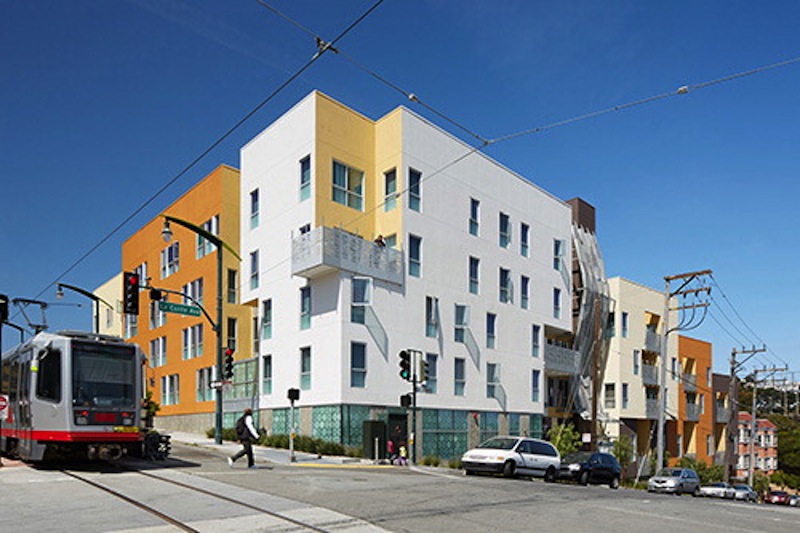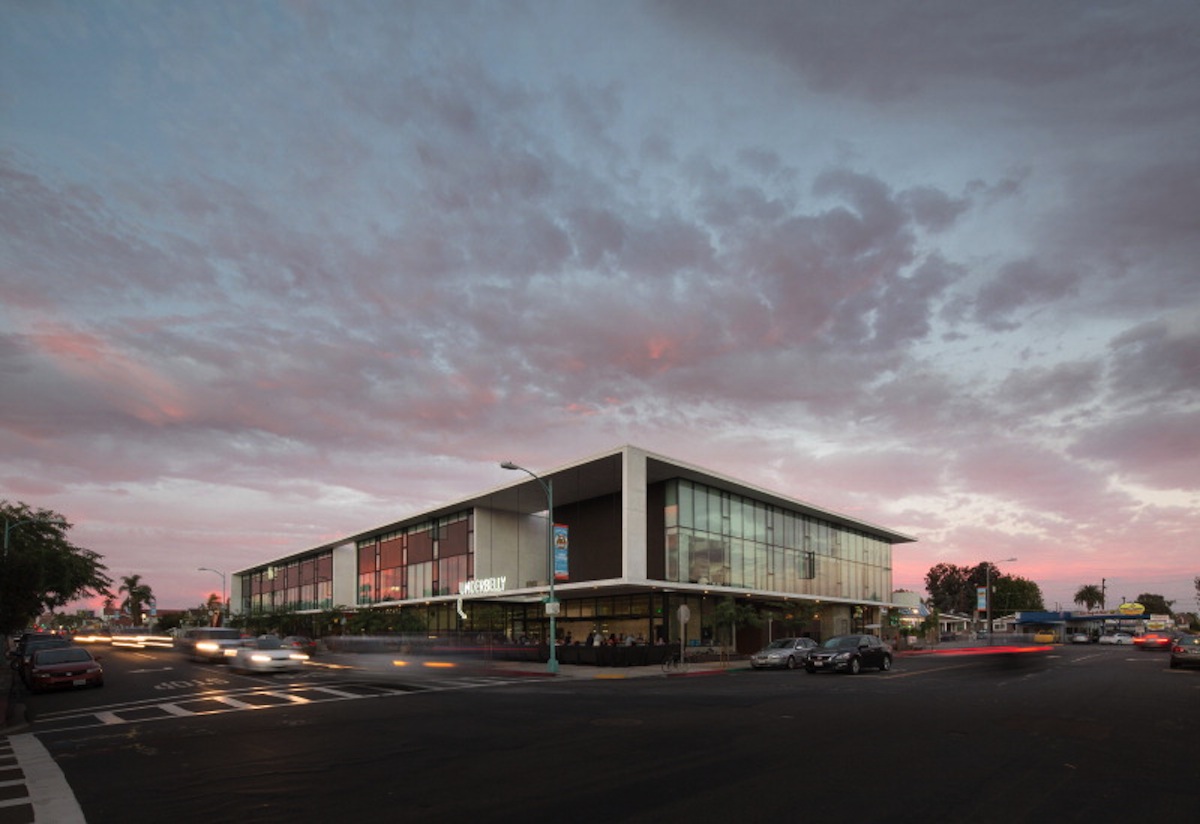The American Institute of Architects (AIA) selected the winners of its 2015 Housing Awards. The competition honored 10 projects across the country, including three affordable projects in the Multifamily Housing category.
The Multifamily Housing award recognizes outstanding apartment and condominium design. Aside from the architectural design features, the jury chose buildings based on context, transportation options, and features that contirubte to livable communities.
The three multifamily winners are:
Bayview Hill Gardensm, San Francisco
David Baker Architects
 Image: Bruce Damonte and Matt Edge
Image: Bruce Damonte and Matt Edge
After years in the development pipeline, this bright new building now replaces a crime-ridden site with safe and stable homes. This is the only building dedicated to formerly homeless families in its neighborhood, which has the second highest homelessness rate in the city. Its opening moved many families off waiting lists for overtaxed shelters and has reduced pressure on emergency services.
The new secure building brings 73 homes, positive energy, and "eyes on the street" to the neighborhood. Formerly homeless families and transition-aged youth are provided stable new homes with "welcome kits" of furnishings and supplies. A comprehensive range of support services, including child-specific programs are offered in the building's convenient on-site offices. The 115 kids living in the building receive healthy snacks, homework help, after-school care, and chaperoned field trips.
In the central courtyard, 8,500-square-foot urban garden with fruit trees, vines, and planting beds allows residents to grow their own food and get their hands dirty. Varied-height planters accommodate people's differing relationships to the gardening beds - for adults, teens, children, and those with mobility differences - as well as providing places to rest or socialize in the garden court. A local gardening non-profit oversees this "edible landscape," with residents providing the daily garden care.
By providing increased safety and increased housing capacity and density as well as on-site social and vocational services for residents, the development supports residents and fosters the cultural and economic diversity of the neighborhood.
David Baker, FAIA, was the associate architect, interior designer was David Baker Architects, and OLMM Consulting Engineers served as the structural engineer on the project.
Broadway Affordable Housing, Santa Monica, Calif.
Kevin Daly Architects
 Image: Iwan Baan
Image: Iwan Baan
The objective of Broadway Housing is to provide low-income families with affordable housing that is both environmentally and economically sustainable in an urban area with a serious lack of available affordable housing options.
The primary population served by this project is low-income families earning between 30% and 60% of Area Median Income. The property consists of 2- and 3-bedrom units with rents ranging from about $560 to $1,300 per month. A market study was conducted to demonstrate the need for these units in the city. The market study determined that there was a need for 7,931 2-bedroom units serving this income range and 6,725 3-bedroom units within the west side of Los Angeles.
The property's convenient regional and local access and proximity to services make the subject site particularly attractive for the construction of affordable apartments. The complex offers residents two community rooms run by the Boys & Girls Club, computer room, laundry facility, open areas with landscaping and fruit trees, a picnic area, and an on-site manager.
Associate architects on the project were Tom Perkins, Kody Kellogg, Jason Pytko, Gretchen Stoecker, and JAred Ward. TK1SC was the mechanical engineer and John Labib & Associates was the structural engineer.
The North Parker, San Diego
Jonathan Segal, FAIA
 Image: Matthew Segal
Image: Matthew Segal
The North Parker project is now the southern gateway to the newest transitioning neighborhood in San Diego. The corner of 30th Street and Upas Street, previously blighted with decaying structures and a propensity towards vagrants, is now a community gathering point.
The affordable housing project houses 27 units on the floor above the ground plane and four commercial spaces, which consist of two restaurants, a beer-tasting bar, and an architectural office all engaging and interacting with each other. The street level façade recedes into the property, forming outdoor community gathering and interaction spaces serving the retail, thus opening the property completely to the community.
As you move through the project, a true sense of pedestrian-scale and community interaction is evident, as you notice the garden courtyard, private decks, and circulation paths interwoven through the project. There are no gates or boundaries. There are no double-loaded corridors.
The public and constant pedestrian flow secures the property naturally. Public people can move freely throughout the entire property, only limited by low physical boundaries when approaching the individual units. Multiple entrances through different nodes of the project allow you to transfer between the commercial ground plane along the street, to the interior garden and courtyard space and then up the stairs to the second level residential circulation path.
Tenants enter their units through semi-private exterior patios raised two feet above the adjacent public walkway. These raised patios allow for a sense of privacy while maintaining visual connection to the central court, further enhancing the sense of community. Upon entering your private space, you are allowed an unobstructed visual connection all the way through the unit with floor-to-ceiling glazing the full width of the unit peeking straight into the urban public landscape.
DCI Engineers served as the project's structural engineer and SeaBright Company was the civil engineer.
To read the full list of winners from the 15th annual AIA Housing Awards, click here.
Related Stories
Multifamily Housing | Jun 15, 2023
Alliance of Pittsburgh building owners slashes carbon emissions by 45%
The Pittsburgh 2030 District, an alliance of property owners in the Pittsburgh area, says that it has reduced carbon emissions by 44.8% below baseline. Begun in 2012 under the guidance of the Green Building Alliance (GBA), the Pittsburgh 2030 District encompasses more than 86 million sf of space within 556 buildings.
Industry Research | Jun 15, 2023
Exurbs and emerging suburbs having fastest population growth, says Cushman & Wakefield
Recently released county and metro-level population growth data by the U.S. Census Bureau shows that the fastest growing areas are found in exurbs and emerging suburbs.
Engineers | Jun 14, 2023
The high cost of low maintenance
Walter P Moore’s Javier Balma, PhD, PE, SE, and Webb Wright, PE, identify the primary causes of engineering failures, define proactive versus reactive maintenance, recognize the reasons for deferred maintenance, and identify the financial and safety risks related to deferred maintenance.
Mixed-Use | Jun 12, 2023
Goettsch Partners completes its largest China project to date: a mixed-used, five-tower complex
Chicago-based global architecture firm Goettsch Partners (GP) recently announced the completion of its largest project in China to date: the China Resources Qianhai Center, a mixed-use complex in the Qianhai district of Shenzhen. Developed by CR Land, the project includes five towers totaling almost 472,000 square meters (4.6 million sf).
Mixed-Use | Jun 6, 2023
Public-private partnerships crucial to central business district revitalization
Central Business Districts are under pressure to keep themselves relevant as they face competition from new, vibrant mixed-use neighborhoods emerging across the world’s largest cities.
Multifamily Housing | Jun 6, 2023
Minnesota expected to adopt building code that would cut energy use by 80%
Minnesota Gov. Tim Walz is expected to soon sign a bill that would change the state’s commercial building code so that new structures would use 80% less energy when compared to a 2004 baseline standard. The legislation aims for full implementation of the new code by 2036.
Student Housing | Jun 5, 2023
The power of student engagement: How on-campus student housing can increase enrollment
Studies have confirmed that students are more likely to graduate when they live on campus, particularly when the on-campus experience encourages student learning and engagement, writes Design Collaborative's Nathan Woods, AIA.
Multifamily Housing | Jun 1, 2023
Income-based electric bills spark debate on whether they would harm or hurt EV and heat pump adoption
Starting in 2024, the electric bills of most Californians could be based not only on how much power they use, but also on how much money they make. Those who have higher incomes would pay more; those with lower incomes would see their electric bills decline - a concept known as income-based electric bills.
Multifamily Housing | May 30, 2023
Boston’s new stretch code requires new multifamily structures to meet Passive House building requirements
Phius certifications are expected to become more common as states and cities boost green building standards. The City of Boston recently adopted Massachusetts’s so-called opt-in building code, a set of sustainability standards that goes beyond the standard state code.
Multifamily Housing | May 30, 2023
Milhaus, Gershman Partners, and Citimark close on $70 million multifamily development in Indy
Versa will bring 233 studio and one- and two-bedroom apartments to Indianapolis's $271 million, Class-A Broad Ripple Village development enterprise.

















